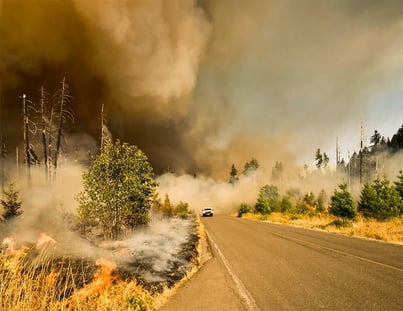Wildfires release dangerous pollutants into the atmosphere. Without the proper protection and foresight, these pollutants can ruin indoor air quality and cause massive health risks. To ensure healthy conditions indoors, occupants and building managers must employ a series of protective efforts that monitor and maintain indoor air quality.

Wildfire season in the United States was once just a four-month season. However, as climate change continues to disrupt historic weather patterns, the season is now 6-8 months and climbing.
The ecological and social damage of wildfires is evident, as up to 8 million acres burn every year in the U.S. alone. Clearly, you shouldn't go outside during a wildfire. However, most people don't understand that wildfires produce additional hazards, such as airborne pollutants, that can impact a much larger population than those directly impacted by the fire. It's important to remember that even indoors, the particulate matter from wildfire smoke can infiltrate homes and cause long-lasting damage.
Knowing how to keep indoor air clean is vital to avoiding the major health effects of poor indoor air quality. One of the best ways to improve indoor air quality is to install a network of indoor air quality sensors. These sensors come with incredible benefits, such as real-time air quality measurements that continually track key metrics, to aid you during wildfires and allow you to act as soon as pollution levels become a concern.
Harmful Air Pollutants Produced by Wildfires
The EPA clearly defines wildfire smoke as a severe concern for respiratory health. Some of the harmful particulate matter produced by wildfires include:
- Carbon Monoxide
- Fine particulate matter (particles smaller than 2.5 microns in diameter)
- Volatile Organic Compounds (VOCs)
A lot of preparation is required to stay safe during wildfires, as any of these harmful indoor pollutants can wreak havoc on human health. Immediate effects can include aggravated asthma, trouble breathing, and eye, nose, and throat irritation. Long-term effects include increased possibility of lung and heart disease.
5 Tips To Maintain Indoor Air Quality During Wildfire Season
Though wildfire smoke is hazardous, there are ways to improve indoor air quality quickly and efficiently. You must take certain precautions before, during, and after a wildfire to ensure indoor air is fit to breathe.
1. Keep Windows and Doors Closed
The main way wildfire smoke enters from the outside is through natural ventilation. In other words, through a door, window, or structural gap or crack.
So, if you detect wildfire smoke outside, ensure all windows and doors are closed. Ideally, it's best to seal off these openings before the smoke reaches your area to preserve the filtered air and improve poor air quality.
2. Turn Off the Fresh Air Option in Your Central Air Conditioning
Some AC units come with a fresh air option, which opens the air duct and brings in fresh, outside air instead of recycling the air inside. Sometimes, especially in rural locations, the outdoor air quality is good enough to use this setting.
However, during wildfires, this setting instead allows filthy, polluted air into the house, producing extremely poor air quality. Check your AC unit for the fresh air option to ensure you know how to turn it off quickly in response to poor outside air conditions.
3. Avoid Generating Indoor Air Pollutants
When cooped up inside for long periods due to wildfire, keeping harmful smoke out isn't enough. It's necessary to do everything possible to preserve and clean the indoor air. For example, smoking indoors essentially defeats the purpose of keeping the wildfire smoke out, and secondhand smoke causes long-term damage to occupants.
Also, use gas stoves as little as possible. Gas stoves emit many harmful pollutants, including methane, carbon monoxide, and nitrogen dioxide. All of these contribute to adverse health effects.
Lastly, refrain from using air fresheners. They might appear a wise choice, given that the air is tainted with wildfire smoke. However, many air fresheners release VOCs, which are harmful without proper ventilation.
4. Use an Air Purifier System
Less than half of households use air purifiers to clean indoor air. Air purifiers are critical indoor air pollution solutions, especially during wildfires, because they use air filters to remove ultra-fine particulate matter that enters your home.
If you lack a purifier system, check the air filter on your HVAC unit. Before a wildfire occurs, change the filter and consider purchasing one with a higher MERV rating. The more filtration, the better your chances of improving air quality by blocking finer particles.
5. Monitor Indoor Air Quality Continuously
The best way to guarantee you're living in a healthy environment during a wildfire isn't by taking a few precautionary measures and hoping for the best.
When monitoring indoor air quality during a wildfire, the best place to start is researching what your local weather station says about the air quality index (AQI). The AQI tracks how much pollution is in the outdoor air. Then, if you have a system of IAQ sensors, you can match these metrics with your indoor air quality to see how your air holds up.
From here, controlling indoor air quality is much easier, given that you can identify exact concerns. Throughout the fires, continuously crossreference the outdoor IAQ with your indoor levels. It'll help you keep track of the major pollutants associated with wildfires.
Ensure Optimal Indoor Air Quality With the Right Solution
Whether it's dust mites or wildfires, you can defend your building from harmful airborne particles by investing in Attune's IoT indoor air quality solutions.
Improving indoor air quality begins with tracking levels of harmful particulates in your building. Partnering with a top-quality brand like Attune is one of the best ways to maintain clean indoor air, even during severe wildfires.
Our IAQ sensors and monitors are UL 2905-certified, meaning they're guaranteed to be among the most accurate and reliable on the market. Even amid significant outdoor smoke, they keep occupants breathing clean, healthy air.
Wildfire season is always right around the corner. If you're interested in investing in Attune's IAQ sensors for your home or building, reach out and schedule a demo today.


